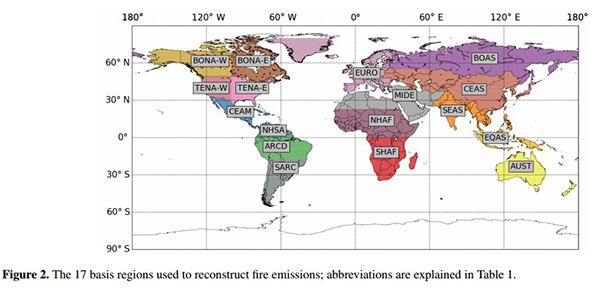最新科研进展
Historic global biomass burning emissions for CMIP6 (BB4CMIP) based on merging satellite observations with proxies and fire models (1750-2015)
Authors:
Margreet J.E. van Marle1, Silvia Kloster2, Brian I. Magi3 Jennifer R. Marlon4, Anne-Laure Daniau5, Robert D. Field6, Almut Arneth7, Matthew Forrest8, Stijn Hantson7, Natalie M. Kehrwald9, Wolfgang Knorr10, Gitta Lasslop2, Fang Li11, Stéphane Mangeon12, Chao Yue13, Johannes W. Kaiser14, Guido R. van der Werf1
1 Faculty of Earth and Life Sciences, Vrije Universiteit Amsterdam, Amsterdam, the Netherlands, 2 Max Planck Institute for Meteorology, Bundesstra?e 53, 20146 Hamburg, Germany, 3 Department of Geography and Earth Sciences, University of North Carolina at Charlotte, Charlotte, North Carolina, USA, 4 School of Forestry and Environmental Studies, Yale University, New Haven, USA, 5 Environnements et Paléoenvironnements Océaniques et Continentaux, UMR EPOC 5805 CNRS, University of Bordeaux, 33615 Pessac, France, 6 NASA Goddard Institute for Space Studies, New York, NY, USA, 7 Karlsruhe Institute of Technology, Institute of Meteorology and Climate research, Atmospheric Environmental Research, 82467 Garmisch-Partenkirchen, Germany, 8 Senckenberg Biodiversity and Climate Research Institute (BiK-F), Senckenberganlage 25, 60325 Frankfurt am Main, Germany, 9 Geosciences and Environmental Change Science Center, U.S. Geological Survey, Lakewood, Colorado, USA, 10 Department of Physical Geography and Ecosystem Science, Lund University, 22362 Lund, Sweden, 11 International Center for Climate and Environmental Sciences, Institute of Atmospheric Physics, Chinese Academy of Sciences, Beijing, China, 12 Department of Physics, Imperial College London, London, United Kingdom, 13 Laboratoire des Sciences du Climate et de l’Environnement, LSCE/IPSL, CEA-CNRS-UVSQ, Universite Paris-Saclay, F-91198 Gif-sur-Yvette, France, 14 Max Planck Institute for Chemistry, Mainz, Germany
Abstract:
Fires have influenced atmospheric composition and climate since the rise of vascular plants, and satellite data has shown the overall global extent of fires. Our knowledge of historic fire emissions has progressively improved over the past decades due mostly to the development of new proxies and the improvement of fire models. Currently there is a suite of proxies including sedimentary charcoal records, measurements of fire-emitted trace gases and black carbon stored in ice and firn, and visibility observations. These proxies provide opportunities to extrapolate emissions estimates based on satellite data starting in 1997 back in time, but each proxy has strengths and weaknesses regarding, for example, the spatial and temporal extents over which they are representative. We developed a new historic biomass burning emissions dataset starting in 1750 that merges the satellite record with several existing proxies, and uses the average of six models from the Fire Model Intercomparison Project (FireMIP) protocol to estimate emissions when the available proxies had limited coverage. According to our approach, global biomass burning emissions were relatively constant with 10-year averages varying between 1.8 and 2.3 Pg C yr-1. Carbon emissions increased only slightly over the full time period and peaked during the 1990s after which they decreased gradually. There is substantial uncertainty in these estimates and patterns varied depending on choices regarding data representation, especially on regional scales. The observed pattern in fire carbon emissions is for a large part driven by African fires, which accounted for 58% of global fire carbon emissions. African fire emissions declined since about 1950 due to conversion of savanna to cropland, and this decrease is partially compensated for by increasing emissions in deforestation zones of South America and Asia. These global fire emissions estimates are mostly suited for global analyses and will be used in the CMIP6 simulations.
Key words:
CMIP6, fire emissions, Global


Citation:
Van Marle, M. J. E., Kloster, S., Magi, B. I., Marlon, J. R., Daniau, A.-L., Field, R. D., Arneth, A., Forrest, M., Hantson, S., Kehrwald, N. M., Knorr, W., Lasslop, G., Li, F., Mangeon, S., Yue, C., Kaiser, J. W., and van der Werf, G. R.: Historic global biomass burning emissions for CMIP6 (BB4CMIP) based on merging satellite observations with proxies and fire models (1750–2015), Geosci. Model Dev., 10, 3329-3357, 2017.
